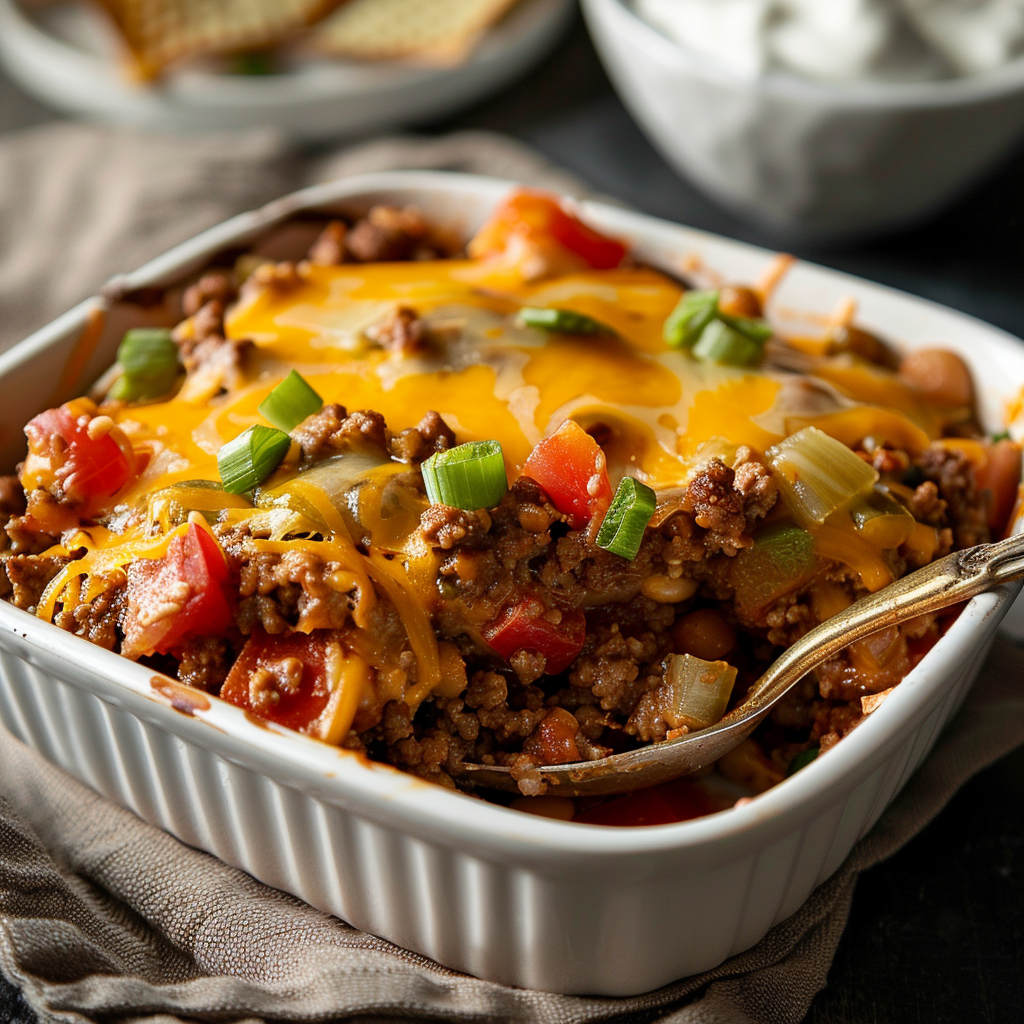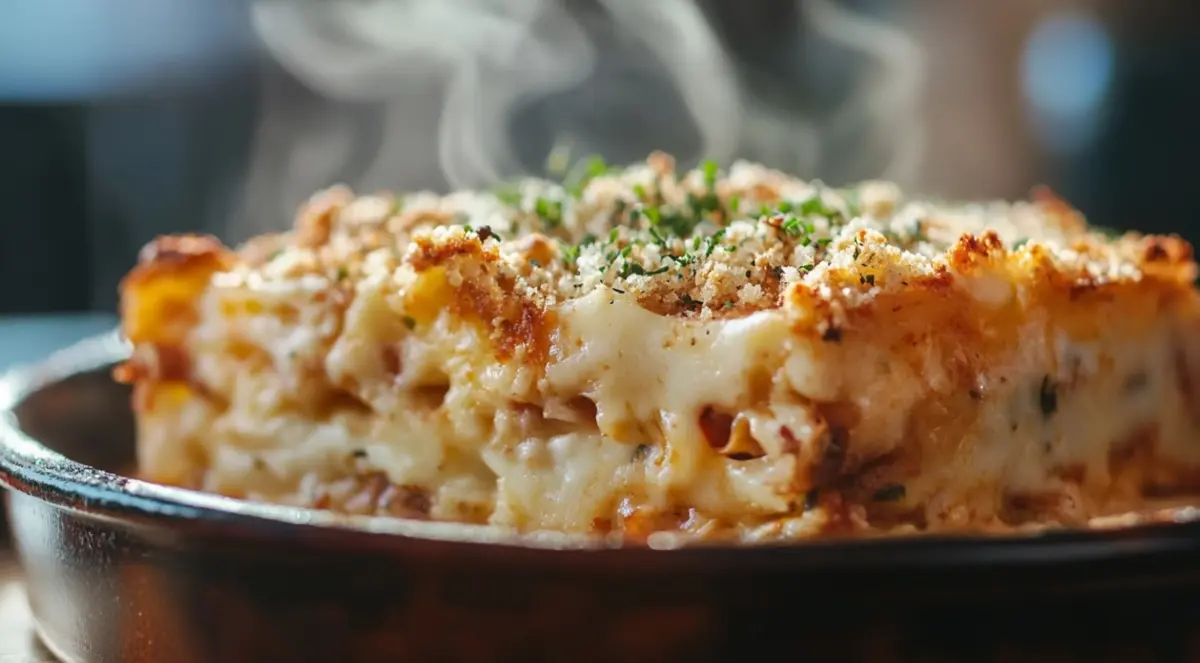There’s something undeniably comforting about a casserole. It’s the dish you turn to when you’re craving warmth, convenience, and the joy of a one-pan meal. But while casseroles have the potential to be absolutely delicious, it’s all too easy to end up with a bland, dry, or unbalanced dish. If you’ve ever had a casserole that left you disappointed, you’re not alone. But the good news is, it doesn’t have to be this way! so we give to you the answer of how do you make a casserole taste better
In this article, you’ll learn exactly how do you make a casserole taste better. Whether you’re an experienced cook or just getting started in the kitchen, these practical tips and tricks will help you take your casserole game to the next level. By mastering a few key elements of seasoning, texture, and ingredient balance, you’ll be creating casseroles that will wow your family and friends every time.
Table of Contents
Why Casseroles Can Fall Flat – Understanding the Common Pitfalls to Make a Casserole Taste Better
Before diving into the solutions of how do you make a casserole taste better, it’s helpful to understand the most common reasons casseroles can fall short in flavor. These issues can typically be traced to three main areas:
1. Lack of Flavor Depth
Casseroles, by their very nature, are a mix of various ingredients—vegetables, meats, sauces, and cheeses. Without proper seasoning and layering of flavors, the result can be a bland and uninspiring dish. One of the biggest mistakes people make is not seasoning the individual layers of the casserole as they go, leading to an overall lack of flavor.
2. Texture Problems
Casseroles can also suffer from texture issues, such as being too dry, too mushy, or unevenly cooked. Certain ingredients may overcook, while others may be underdone, leading to an unappetizing contrast between components. To avoid these issues and how do you make a casserole taste better, it’s crucial to balance the different textures within your casserole to create a harmonious eating experience.
3. Not Enough Fat or Seasoning
Another issue that can make casseroles taste flat is a lack of richness. Fat (in the form of butter, cream, or cheese) is essential for giving a casserole its mouthwatering, indulgent texture. Similarly, without the right amount of seasoning, even the most well-balanced casserole will feel lackluster. So, how do you make a casserole taste better? By adding the right balance of fat and seasoning, you can elevate your casserole to a whole new level of flavor and richness.
How to Add Flavor to Your Casserole – The Essentials for Making It Taste Better
Now that we know what can go wrong, let’s look at how you can improve your casserole’s flavor profile. The key to a great casserole lies in layering your flavors and incorporating ingredients that complement each other perfectly.
1. Master the Art of Seasoning
You can’t expect a casserole to be delicious if you skip the seasoning. Here’s how to get it right:
- Season Every Layer: Whether you’re working with vegetables, proteins, or sauces, it’s important to season each layer as you build the casserole. That way, each component is infused with flavor, not just the surface.
- Use Fresh Herbs: Fresh herbs such as basil, thyme, rosemary, and parsley can do wonders for the overall flavor. They add an aromatic, bright element that dried herbs simply can’t match.
- Be Bold with Spices: Don’t be afraid to experiment with a variety of spices to add depth and warmth. A dash of garlic powder, paprika, onion powder, or cumin can elevate your casserole’s flavor.
2. Add Bold Ingredients for a Flavor Boost
Some ingredients are naturally packed with umami and richness, making them perfect for casserole dishes:
- Cheese: A casserole without cheese is like a movie without a plot. It just doesn’t work. Choose cheeses like cheddar, mozzarella, Parmesan, or even blue cheese for a depth of flavor and a creamy, melt-in-your-mouth texture.
- Umami-Rich Ingredients: Adding ingredients like soy sauce, mushrooms, or anchovies can bring out the savory depth that every casserole needs. These umami-packed additions create a fuller, more satisfying taste.
3. Balance Flavors with Acid
Adding a touch of acidity can balance out the richness and creaminess of your casserole. A squeeze of lemon, a splash of vinegar, or even some tangy tomatoes can cut through the heaviness and brighten up the overall flavor profile.
Perfecting Texture: How to Avoid Common Casserole Mistakes
Achieving the right texture is just as important as seasoning when it comes to making a great casserole. Here’s how do you make a casserole taste better:
1. Balancing Crunch and Creaminess
One of the best ways to create a satisfying casserole is to balance creamy, rich layers with a crunchy topping. This gives the dish a wonderful contrast in both flavor and texture.
- Toppings to Add Crunch: Panko breadcrumbs, crushed crackers, or crispy fried onions are all excellent choices for adding that satisfying crunch to the top of your casserole.
- Don’t Overdo the Creaminess: Too much creamy sauce can lead to a soggy casserole. Be mindful of the sauce-to-ingredient ratio, and don’t overwhelm your casserole with excess liquid.
2. Layer Ingredients for Even Cooking
For a casserole to cook evenly, it’s important to layer your ingredients thoughtfully.
- Layer Proteins and Vegetables: Start by layering heartier ingredients like meats or root vegetables at the bottom of the dish, as they will take longer to cook. Then, add lighter ingredients like cheese or breadcrumbs on top.
- Use the Right Cooking Time: Be sure to cook the casserole at the right temperature for the right amount of time. Cooking too long can dry out the dish, while undercooking can result in raw vegetables or meat.
3. Add a Creamy Base
If you want your casserole to be rich and moist, start with a creamy base. Whether it’s a creamy soup (like cream of mushroom or cream of chicken) or a homemade béchamel sauce, this foundation will ensure that your casserole remains tender and full of flavor.
Creative Variations to Make Your Casserole Stand Out and Taste Better

If you want your casseroles to be even more memorable, try stepping outside of the traditional recipes and incorporating unique ingredients or flavor profiles. Here are a few ideas to how do you make a casserole taste better:
1. Experiment with Different Proteins
Casseroles are incredibly versatile, and you can use almost any protein you prefer. While chicken, beef, and pork are popular choices, don’t be afraid to try other proteins like:
- Ground Meat: Ground turkey, chicken, or beef work wonderfully in casseroles because they easily absorb flavors.
- Seafood: Shrimp or salmon can add a deliciously different twist to a traditional casserole, especially if you’re aiming for a lighter or Mediterranean-inspired dish.
2. Add Veggies for Extra Nutrients and Flavor
The right vegetables can bring both flavor and nutritional value to your casserole. Try incorporating:
- Sweet Potatoes: These add a natural sweetness that pairs wonderfully with savory ingredients.
- Spinach or Kale: These leafy greens add color, texture, and a touch of earthiness.
- Peas, Carrots, and Bell Peppers: These vegetables provide crunch, color, and a slight sweetness.
3. Try International Flavors for a Twist
If you’re feeling adventurous, give your casserole a global flair by adding ingredients from different cuisines. For example:
- Mediterranean Casserole: Use ingredients like feta cheese, olives, and sundried tomatoes to create a Mediterranean-inspired casserole.
- Mexican Casserole: Layer in black beans, corn, chili powder, and cilantro for a deliciously spicy and savory casserole.
Quick Casserole Recipe for Inspiration
Here’s a simple recipe to help you get started on making a casserole that bursts with flavor:
| Ingredient | Amount |
|---|---|
| Chicken (cubed) | 2 cups |
| Cream of Mushroom Soup | 1 can |
| Cheddar Cheese | 1 ½ cups |
| Panko Breadcrumbs | 1 cup |
| Garlic Powder | 1 tsp |
| Fresh Parsley | 2 tbsp |
| Salt and Pepper | To taste |
Instructions:
- Preheat your oven to 375°F (190°C).
- In a large bowl, mix cubed chicken with the cream of mushroom soup and garlic powder.
- Transfer the mixture to a casserole dish, spreading it out evenly.
- Sprinkle the shredded cheddar cheese over the top, followed by a layer of panko breadcrumbs for crunch.
- Bake for 25–30 minutes until the casserole is golden and bubbly.
- Garnish with fresh parsley and serve hot.
FAQ: how do you make a casserole taste better
1. How can I make my casserole less bland?
how do you make a casserole taste better, be sure to season every layer of your dish, from vegetables to proteins. Use fresh herbs and bold spices to add complexity, and don’t forget about umami-rich ingredients like soy sauce or mushrooms. Seasoning each component individually ensures a balanced flavor profile that will elevate the overall dish.
2. How do I prevent my casserole from being too dry?
A creamy sauce base is essential for keeping your casserole moist. Additionally, be sure to cover your casserole while baking to retain moisture, and add a crunchy topping toward the end of cooking for texture.
3. Can I prepare my casserole ahead of time?
Absolutely! You can prepare your casserole the night before and store it in the fridge. When you’re ready to cook, simply bake it straight from the refrigerator (you may need to add a few extra minutes to the cooking time).

Conclusion: Transform Your Casserole into a Culinary Masterpiece
how do you make a casserole taste better ,With a little attention to detail and a few simple techniques, you can easily turn a basic casserole into a showstopper. By mastering seasoning, balancing textures, and experimenting with different ingredients, your casseroles will taste better than ever before. So the next time you’re craving a comforting dish, use these tips to create a casserole that’s packed with flavor, depth, and satisfaction.

